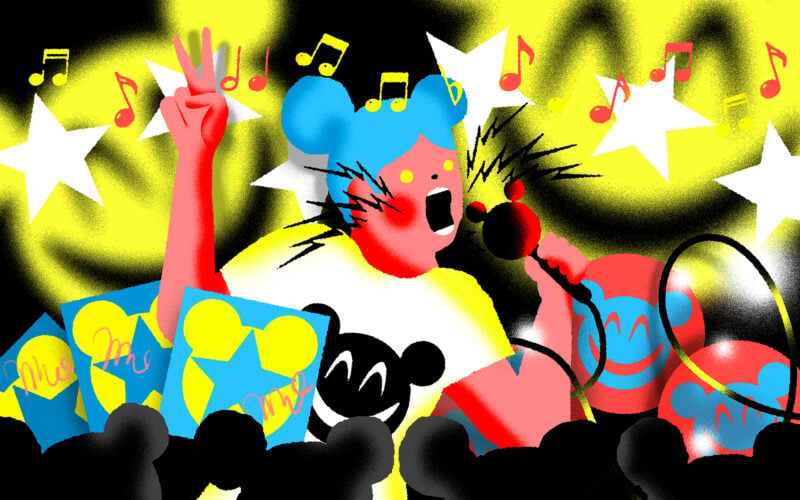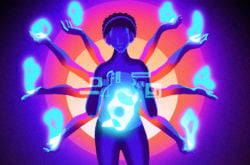Illustration: Daniel Zender
A musician or group’s ‘brand’ is simply a set of self-imposed guidelines to help plan release campaigns and promotional materials.
You are your own creative director. You can dream as big or as humble as you’d like. You can keep things simple, or create a huge artist persona à la Ziggy Stardust. You can also change your brand anytime you like, ideally strategically and thoughtfully.
The purpose of your brand is to build awareness of your music—to develop recognition, a reputation, and a following. A brand helps bring intentionality to how you market your music and provides consistency in your promotional materials. It provides something for both your fans and music industry professionals to latch onto. It also demonstrates to the latter that you’re thinking about the business side of your art (even if you want little to do with it) and that you’re serious about promoting your music.
What is your brand?
Your brand is how you present your artist self and your music to the public. It’s how you channel the energy of your music into your written and visual communications.
Your brand assets are the details that contribute to your overall brand image, such as:
- your visual identity: press photos, your band / project / act logo (if you have one), how you dress on stage, etc.
- the overall voice and tone of your messaging (seen and heard through your social media, artist website, interviews, etc.)
- your bio and / or background story
- the story and message behind each project
- the art for each release—album covers and other packaging and inserts
- your merchandise
Overwhelmed? Don’t worry—we’re going to break down this process for you so it’s simple and fun.
Where to start: Defining your message, setting goals, and identifying an audience
If you’re reading this article, you’re likely feeling ready to share your music and your message with the world (or maybe just a specific group). Or, you want to score films or video games and know you need to put yourself out there to build your network and get gigs.
When identifying goals, I like to start broad and get more specific until goals become easy-to-accomplish tasks. If your number-one big, broad goal is to reach people with your message, the first step is to refine that message until it’s your crystal clear guiding light. Here are some examples:
- Rage Against the Machine railed against war, racism, corporate America, cultural imperialism, government oppression, the establishment, and the capitalist system.
- Charlotte Adigéry and Bolis Pupul focus on cultural appropriation, misogyny, racism, social media vanity, post-colonialism, and political correctness in their art.
- Electronic artist David Slowing processes life events and the emotions that come with them (like grief, for example) through his instrumental music, creating a comforting sonic atmosphere for others to process their own experiences.
The message(s) shared through your music will also show in all aspects of your branding, from the fonts you choose for marketing channels (social media posts, newsletters, posters, etc.) to the clothes you wear and beyond. I’m not suggesting you change the way you dress to match your sonic brand—quite the opposite. In all likelihood, you already exude your message in your style and appearance. I’m suggesting you lean into that and allow your branding materials to reflect your personality and performing style.
Megan Thee Stallion’s Nike campaign is the ultimate example of branding that moves her message forward, even though she’s mostly promoting another brand:
Still not sure what you’re trying to accomplish with your music? Try writing down the answers to these simple questions:
- Why do I make music?
- Why do I make the specific music I make?
- How do I feel when I make my music?
- How do I feel when I listen to my music?
- How do I want others to feel when they listen to my music?
The answer to the last three questions could be a simple word, such as empowered, pensive, relief, gratitude, happy, seen, in process, etc. It doesn’t have to be a complex message of anti-war idealism or some grandiose goal. Each of those emotions can easily be communicated through visuals.
I’m not a big fan of the “start with ‘the why'” approach. I prefer the idea of making the art you want to make, and then asking who else would be into it, why they’d be into it, and why you want to share it with them. The answer could be to earn a living from your art or to make people feel better. I think asking yourself ‘why?’ somewhere in the middle of your process can create clarity and motivation for continued work.
Identifying your business goals
If you want to sell or earn income from your music, you are a business (well, you’re specifically a freelancer, but that’s a different article). Every business needs goals to keep it focused in a meaningful way. Once you have your artistic message down, you’ll need to identify the best income channels for your work.
Try asking yourself: Why am I ready to develop my brand?
That answer should direct you in the area in which to focus your branding and marketing. For example, you could need to:
- develop relationships with music supervisors and trailer houses so you can become a go-to composer.
- build an audience on social media who’ll include your bangers in their TikTok videos, springboarding you to viral fame.
- prove yourself as an excellent producer and gain the attention of the artist who’ll give you your big break.
- start reaching out to record labels to release and market your upcoming record so you can focus on your art rather than fundraising and selling records.
- pitch to sync agents who can rep you to music supervisors to get your recorded music placed in films, TV, commercials, and video games.
The number one and two things these audiences will care about are 1) the quality of your music, and 2) its relevance to their audience. That said, they’ll also like to see that you’re working hard and that you have momentum, typically signaled by an existing fan base—even if it’s small but loyal.
If you want to be more than one of these things, think about how they fit together and in what ways they intersect. How can your brand help you achieve both goals?
Exploring channels of opportunity
If you’re still not sure where your music belongs in the world (distributed to the public, heard in films, positioned for TikTok fame, and so on), try diving deeper with these questions:
- Are you prolific, or does it take significant time to produce a completed project?
- Do you enjoy the collaborative elements of making music, or do you prefer to work alone or do everything yourself?
- Do you like helping artists complete their projects, or do you prefer to focus on your own work?
- How does being on your phone and computer make you feel? Do you like connecting with people on social media?
- Do you like to be hands-on with marketing decision-making, or would you prefer if someone made the decisions for you?
- Do you enjoy the attention of being on stage or the energy you get from performing? Or, do you prefer creating behind the scenes?
- Do you enjoy touring and traveling, or is it better for your lifestyle to stay close to home?
Answering these questions will help you identify a business model that best suits your lifestyle goals and music—working as a prolific content-making machine, a picky producer working only with the best, a beat maker selling sample packs, an in-demand commercial composer, a chart-topping hitmaker, and so on. The goals for each will be different.
Here are some example goals:
- Sell 400 cassettes to break even and fund my next recording session
- Compose for six commercials this quarter to raise enough money for that synth I need for my band project
- Sign with a reputable label that will help grow my audience by 150%
- Secure sponsorship / funding for the festival I’m planning
- Book three mid-sized festivals this summer to fund the rest of our tour
- Secure placement as the supporting act for an arena band
- Land a sync licensing deal with a major motion picture
You get the point!
Planning your brand
Now that you have some goals to aspire towards and know who your audience is, you can start planning your branding assets. Below are the essentials.
Voice and tone
How you speak to your audience is just as important of a branding element as your visual identity. Your tone indicates your attitude, and sets the stage for what your fans can expect from you on the literal stage.
I think of Kevin Morby’s Instagram presence, especially his Stories, which are representative of his stage presence. Bill Callahan’s Twitter tone is extremely reflective of his dry, witty banter on stage. Instagram posts from Alex Peterson of Alexalone reflect the sincerity and gratitude that emanate through their performances—even when they don’t speak to the audience much, they let the music do most of the talking.
When I work with brand clients, I ask them to choose a few words that represent characteristics they want their messaging (the words that go on their website, social media, newsletters, etc.) to exude and others they want to avoid. I give examples like fun, knowledgeable, upbeat, kind, sassy, elegant, casual, formal, snobby, condescending, goofy, casual, formal, cheesy, dry, direct, indirect, etc. Identifying these will come in handy for when you start building a team that’ll potentially take over these things for you.
Although scrolling for inspiration can be helpful, make sure your personality and unique voice shine through if you’re writing your own copy / words. Make it fun, as if you’re talking to a friend. Your fans will appreciate the authenticity. If you’re naturally dry and formal, that’s cool too—just be you.
Assets
Gather a list of your branding assets so you can start developing a cohesive picture of what your brand will look like. All of these will also go into your electronic press kit (EPK), which is an assets folder containing your bio, promo photos, press coverage, music, videos, etc. These will be useful not just for press outreach, but also when reaching out to record labels, publishers, brands, grant opportunities, etc.
Typical branding assets include (but are not limited to):
- album covers
- artist website
- social media profiles
- logo (sometimes—we cover these below)
- press photos (if you look at any band photos, you’ll notice they don’t necessarily have to be ‘professional;’ they just need to look attractive to their target audience)
- videos
List out all of your branding assets so that you’re able to keep the whole picture in mind as you make decisions about each.
Does your musical project need a logo?
The short answer is: probably not. That said, though they’re a bit outdated, they are effective. I did some solo brainstorming and asked my Twitter community to see what came to mind and we all came up with way more memorable logos than I expected.
Examples spanned old-school rock n’ roll and punk outfits (Rolling Stones, Black Flag, Metallica, Nirvana, The Doors, Bauhaus) to electronic projects (Daft Punk, Deadmau5, Drexciya), hip hop acts (Run-D.M.C., Nas, Eminem, Public Enemy, Wu-Tang Clan, Outkast), and jam bands (Grateful Dead, Phish, Dave Matthews Band). And then there’s Nine Inch Nails, which kinda falls into its own category. For more contemporary acts, I think of WOODS, Ween, Snarky Puppy, Flume, and Sunn O))).
Okay, so maybe logos aren’t so outdated after all, and might be a worthwhile consideration!
Who to work with
Even if you can develop all of this yourself, should you? Delegation can help prevent overwhelm and give you more time to put final touches on your music project. Bringing others in also provides an ‘outsider’s’ perspective on how your music is interpreted by fans.
If you do work with others, find people who understand you and what you’re trying to accomplish. Give it a test run with something like a show or livestream poster to see how you work together. Can’t afford to hire someone? Consider a fair and equal trade. Maybe you mix their album in return if they’re a musician. Or, perhaps you’re a carpenter by day and can build them their dream bookshelf. I’m currently trading copywriting work for a logo for one of my side projects, and it’s going so well.
Recap: What you need to develop a brand
First and foremost, you need to be in a good place to make decisions. I mostly mean headspace, but maybe your environment should be right too. Consider getting a whiteboard or doing these exercises from your favorite room or coffee shop. Once you’re ready to get to work, here’s what you’ll be considering:
- Your goals
- Your audience
- Your message
- How your music will earn income
- The tone you want to emanate
- The assets you need to reach your goals
- The people who will help you (if any)
Most importantly, try to make it fun.
In the meantime, what musical acts have logos or branding that resonates with you as a fan? Let us know in the comments below.
Explore royalty-free sounds from leading artists, producers, and sound designers:
September 27, 2021



